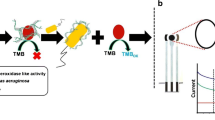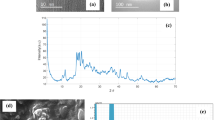Abstract
A novel non-enzyme electrochemical biosensor for the rapid detection of Gram-positive bacteria has been constructed that relys on a stable and efficient combination between the peptidoglycan layer and platinum-nickel-copper nanocubes (Pt-Ni-Cu NCs). Briefly, bacteria were first captured by a specific antibody. Then, the electrochemical signal materials (Pt-Ni-Cu NCs) were bound to the bacteria peptidoglycan layer using specific structural and surface features. The rapid and sensitive bacterial detection was then achieved using intrinsic electrochemical characteristics and superoxidase-like activity of the Pt-Ni-Cu NCs. Moreover, the nature of peptidoglycan covering the whole bacteria provided the premise for signal amplification. Under optimal conditions, the electrochemical signal variation was proportional to the concentration of bacteria ranging from 1.5 × 102 to 1.5 × 108 CFU/mL with a detection limit of 42 CFU/mL using a working potential of − 0.4 V. This electrochemical biosensor has been successfully applied to detect bacteria concentrations in urine samples, and the recoveries range from 90.4 to 107%. The proposed biosensor could be applied for broad-spectrum detection of Gram-positive bacteria since most Gram-positive bacteria possess a thick peptidoglycan layer. The developed electrochemical biosensing strategy might be used as a potential tool for clinical pathogenic bacteria detection and point-of-care testing (POCT).







Similar content being viewed by others
References
Al Tall Y, Abualhaijaa A, Alsaggar M, Almaaytah A, Masadeh M, Alzoubi KH (2019) Design and characterization of a new hybrid peptide from LL-37 and BMAP-27. Infect Drug Resist 12:1035–1045. https://doi.org/10.2147/IDR.S199473
Goad B, Harris LK (2018) Identification and prioritization of macrolideresistance genes with hypothetical annotation inStreptococcus pneumoniae. Bioinformation 14(9):488–498. https://doi.org/10.6026/97320630014488
Koirala B, Phillips NR, Tal-Gan Y (2019) Unveiling the importance of amide protons in CSP:ComD interactions in Streptococcus pneumoniae. ACS Med Chem Lett 10(6):880–886. https://doi.org/10.1021/acsmedchemlett.9b00038
Panda PS, Chaudhary U, Dube SK (2016) Comparison of four different methods for detection of biofilm formation by uropathogens. Indian J Pathol Microbiol 59(2):177–179. https://doi.org/10.4103/0377-4929.182013
Borghei Y, Hosseini M, Ganjali MR (2017) Fluorometric determination of microRNA via FRET between silver nanoclusters and CdTe quantum dots. Microchim Acta 184(12):4713–4721. https://doi.org/10.1007/s00604-017-2512-9
Zhao H, Shu G, Zhu J, Fu Y, Gu Z, Yang D (2019) Persistent luminescent metal-organic frameworks with long-lasting near infrared emission for tumor site activated imaging and drug delivery. Biomaterials 217:e119332. https://doi.org/10.1016/j.biomaterials.2019.119332
Han DB, Yan YR, Wang JM et al (2019) An enzyme-free electrochemiluminesce aptasensor for the rapid detection of Staphylococcus aureus by the quenching effect of MoS2-PtNPs-vancomycin to S2O82−/O2 system. Sensors Actuators B Chem 288:586–593. https://doi.org/10.1016/j.bios.2013.03.084
Zhang L, Deng H, Yuan R, Yuan Y (2019) Electrochemical lead(II) biosensor by using an ion-dependent split DNAzyme and a template-free DNA extension reaction for signal amplification. Microchim Acta 186(11). https://doi.org/10.1007/s00604-019-3857-z
Asif M, Haitao W, Shuang D, Aziz A, Zhang G, Xiao F, Liu H (2017) Metal oxide intercalated layered double hydroxide nanosphere: with enhanced electrocatalyic activity towards H2O2 for biological applications. Sensors Actuators B Chem 239:243–252. https://doi.org/10.1016/j.snb.2016.08.010
Guo B, Wen B, Cheng W, Zhou X, Duan X, Zhao M, Xia Q, Ding S (2018) An enzyme-free and label-free surface plasmon resonance biosensor for ultrasensitive detection of fusion gene based on DNA self-assembly hydrogel with streptavidin encapsulation. Biosens Bioelectron 112:120–126. https://doi.org/10.1016/j.bios.2018.04.027
Asif M, Aziz A, Azeem M, Wang Z, Ashraf G, Xiao F, Chen X, Liu H (2018) A review on electrochemical biosensing platform based on layered double hydroxides for small molecule biomarkers determination. Adv Colloid Interf Sci 262:21–38. https://doi.org/10.1016/j.cis.2018.11.001
Asif M, Liu H, Aziz A, Wang H, Wang Z, Ajmal M, Xiao F, Liu H (2017) Core-shell iron oxide-layered double hydroxide: high electrochemical sensing performance of H2O2 biomarker in live cancer cells with plasma therapeutics. Biosens Bioelectron 97:352–359. https://doi.org/10.1016/j.bios.2017.05.057
Luo C, Tang H, Cheng W, Yan L, Zhang D, Ju H, Ding S (2013) A sensitive electrochemical DNA biosensor for specific detection of Enterobacteriaceae bacteria by Exonuclease III-assisted signal amplification. Biosens Bioelectron 48:132–137. https://doi.org/10.1016/j.bios.2013.03.084
Maduraiveeran G, Sasidharan M, Ganesan V (2018) Electrochemical sensor and biosensor platforms based on advanced nanomaterials for biological and biomedical applications. Biosens Bioelectron 103:113–129. https://doi.org/10.1016/j.bios.2017.12.031
Xu L, Liu Z, Lei S, Huang D, Zou L, Ye B (2019) A sandwich-type electrochemical aptasensor for the carcinoembryonic antigen via biocatalytic precipitation amplification and by using gold nanoparticle composites. Microchim Acta 186(7):473. https://doi.org/10.1007/s00604-019-3542-2
Jiang HL, Ma X, Wang L, Zhang Q (2019) Switching on photocatalysis of metal-organic frameworks by engineering structural defects. Angew Chem Int Ed Eng 131:12303–12307. https://doi.org/10.1002/anie.201907074
Sun X, Tao Y, Du Y, Ding W, Chen C, Ma X (2019) Metal organic framework HKUST-1 modified with carboxymethyl-β-cyclodextrin for use in improved open tubular capillary electrochromatographic enantioseparation of five basic drugs. Microchim Acta 186(7):462–469. https://doi.org/10.1007/s00604-019-3584-5
Ohtani M, Muraoka T, Okimoto Y, Kobiro K (2017) Rapid one-pot solvothermal batch synthesis of porous nanocrystal assemblies composed of multiple transition-metal elements. Inorg Chem 56(19):11546–11551. https://doi.org/10.1021/acs.inorgchem.7b01192
Li W, Chen B, Zhang H, Sun Y, Wang J, Zhang J, Fu Y (2015) BSA-stabilized Pt nanozyme for peroxidase mimetics and its application on colorimetric detection of mercury(II) ions. Biosens Bioelectron 66:251–258. https://doi.org/10.1016/j.bios.2014.11.032
Xu X, Zhang X, Sun H, Yang Y, Dai X, Gao J, Li X, Zhang P, Wang HH, Yu NF, Sun SG (2014) Synthesis of Pt-Ni alloy nanocrystals with high-index facets and enhanced electrocatalytic properties. Angew Chem Int Ed Eng 53(46):12522–12527. https://doi.org/10.1002/anie.201406497
Mostafa S, Behafarid F, Croy JR, Ono LK, Li L, Yang JC, Frenkel AI, Cuenya BR (2010) Shape-dependent catalytic properties of Pt nanoparticles. J Am Chem Soc 132(44):15714–15719. https://doi.org/10.1021/ja106679z
Jin L, Meng Z, Zhang Y, Cai S, Zhang Z, Li C, Shang L, Shen Y (2017) Ultrasmall Pt nanoclusters as robust peroxidase mimics for colorimetric detection of glucose in human serum. ACS Appl Mater Interfaces 9(11):10027–10033. https://doi.org/10.1021/acsami.7b01616
Mu X, Wang J, Li Y, Xu F, Long W, Ouyang L, Liu H, Jing Y, Wang J, Dai H, Liu Q, Sun Y, Liu C, Zhang XD (2019) Redox trimetallic nanozyme with neutral environment preference for brain injury. ACS Nano 13(2):1870–1884. https://doi.org/10.1021/acsnano.8b08045
Asif M, Aziz A, Wang Z, Ashraf G, Wang J, Luo H, Chen X, Xiao F, Liu H (2019) Hierarchical CNTs@CuMn layered double hydroxide nanohybrid with enhanced electrochemical performance in H2S detection from live cells. Anal Chem 91(6):3912–3920. https://doi.org/10.1021/acs.analchem.8b04685
Pei F, Wang P, Ma E, Yu H, Gao C, Yin H, Li Y, Liu Q, Dong Y (2018) A sandwich-type amperometric immunosensor fabricated by Au@Pd NDs/Fe2+-CS/PPy NTs and Au NPs/NH2-GS to detect CEA sensitively via two detection methods. Biosens Bioelectron 122:231–238. https://doi.org/10.1016/j.bios.2018.09.065
Babamiri B, Bahari D, Salimi A (2019) Highly sensitive bioaffinity electrochemiluminescence sensors: recent advances and future directions. Biosens Bioelectron 142:111530. https://doi.org/10.1016/j.bios.2019.111530
Cabeen MT, Jacobs-Wagner C (2005) Bacterial cell shape. Nat Rev Microbiol 3(8):601–610. https://doi.org/10.1038/nrmicro1205
Johnson JW, Fisher JF, Mobashery S (2013) Bacterial cell-wall recycling. Ann N Y Acad Sci 1277:54–75. https://doi.org/10.1111/j.1749-6632.2012.06813.x
Wu R, Ma Y, Pan J, Lee SH, Pan G (2017) Efficient capture, rapid killing and ultrasensitive detection of bacteria by a nano-decorated multi-functional electrode sensor. Biosens Bioelectron 101:52–59. https://doi.org/10.1016/j.bios.2017.10.003
Kashyap DR, Wang M, Liu LH, Boons GJ, Gupta D, Dziarski R (2011) Peptidoglycan recognition proteins kill bacteria by activating protein-sensing two-component systems. Nat Med 17(6):676–683. https://doi.org/10.1038/nm.2357
Turner RD, Hurd AF, Cadby A, Hobbs JK, Foster SJ (2013) Cell wall elongation mode in Gram-negative bacteria is determined by peptidoglycan architecture. Nat Commun 4:1496–1503. https://doi.org/10.1038/ncomms2503
Girardin SE, Boneca IG, Carneiro LA et al (2003) Nod1 detects a unique muropeptide from gram-negative bacterial peptidoglycan. Science 300(5625):1584–1587. https://doi.org/10.1126/science.1084677
Fang G, Li W, Shen X, Perez-Aguilar JM, Chong Y, Gao X, Chai Z, Chen C, Ge C, Zhou R (2018) Differential Pd-nanocrystal facets demonstrate distinct antibacterial activity against Gram-positive and Gram-negative bacteria. Nat Commun 9(1):129–137. https://doi.org/10.1038/s41467-017-02502-3
Ye JS, Chen C, Lee C (2015) Pd nanocube as non-enzymatic glucose sensor. Sensors Actuators B Chem 208:569–574. https://doi.org/10.1016/j.snb.2014.11.091
Niroula J, Premaratne G, Ali Shojaee S, Lucca DA, Krishnan S (2016) Combined covalent and noncovalent carboxylation of carbon nanotubes for sensitivity enhancement of clinical immunosensors. Chem Commun (Camb) 52(88):13039–13042. https://doi.org/10.1039/c6cc07022a
Wu Y, Wang D, Chen X, Zhou G, Yu R, Li Y (2013) Defect-dominated shape recovery of nanocrystals: a new strategy for trimetallic catalysts. J Am Chem Soc 135(33):12220–12223. https://doi.org/10.1021/ja4068063
Feng X, Zhang Y, Zhou J, Li Y, Chen S, Zhang L, Ma Y, Wang L, Yan X (2015) Three-dimensional nitrogen-doped graphene as an ultrasensitive electrochemical sensor for the detection of dopamine. Nanoscale 7(6):2427–2432. https://doi.org/10.1039/c4nr06623e
Wei Y, Li X, Sun X, Ma H, Zhang Y, Wei Q (2017) Dual-responsive electrochemical immunosensor for prostate specific antigen detection based on Au-CoS/graphene and CeO2/ionic liquids doped with carboxymethyl chitosan complex. Biosens Bioelectron 94:141–147. https://doi.org/10.1016/j.bios.2017.03.001
Aziz A, Asif M, Azeem M, Ashraf G, Wang Z, Xiao F, Liu H (2019) Self-stacking of exfoliated charged nanosheets of LDHs and graphene as biosensor with real-time tracking of dopamine from live cells. Anal Chim Acta 1047:197–207. https://doi.org/10.1016/j.aca.2018.10.008
Asif M, Aziz A, Wang H, Wang Z, Wang W, Ajmal M, Xiao F, Chen X, Liu H (2019) Superlattice stacking by hybridizing layered double hydroxide nanosheets with layers of reduced graphene oxide for electrochemical simultaneous determination of dopamine, uric acid and ascorbic acid. Microchim Acta 186(2):61–71. https://doi.org/10.1007/s00604-018-3158-y
Funding
This study was financially supported by the National Natural Science Foundation of China (81873980, 81873972, 21804015), the National Science and Technology Major Project of the Ministry of Science and Technology of China (2018ZX10732202), and the Natural Science Foundation Project of CQ (cstc2018jcyjAX0201, cstc2018jcyjAX0251).
Author information
Authors and Affiliations
Corresponding author
Ethics declarations
Conflict of interest
The authors declare no competing interests.
Additional information
Publisher’s note
Springer Nature remains neutral with regard to jurisdictional claims in published maps and institutional affiliations.
Electronic supplementary material
ESM 1
(DOCX 210 kb)
Rights and permissions
About this article
Cite this article
Han, D., Yan, Y., Bian, X. et al. A novel electrochemical biosensor based on peptidoglycan and platinum-nickel-copper nano-cube for rapid detection of Gram-positive bacteria. Microchim Acta 187, 607 (2020). https://doi.org/10.1007/s00604-020-04581-4
Received:
Accepted:
Published:
DOI: https://doi.org/10.1007/s00604-020-04581-4




